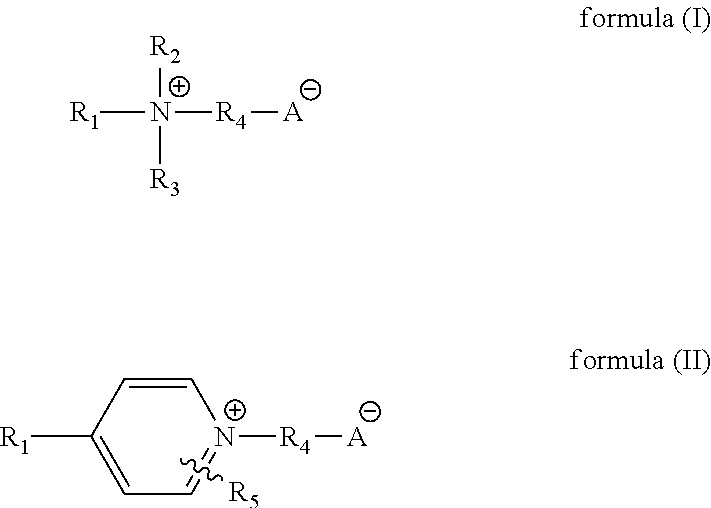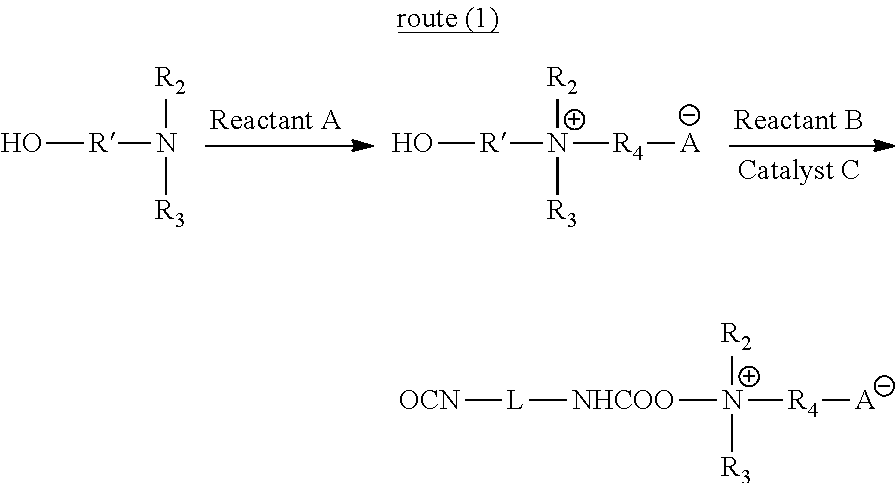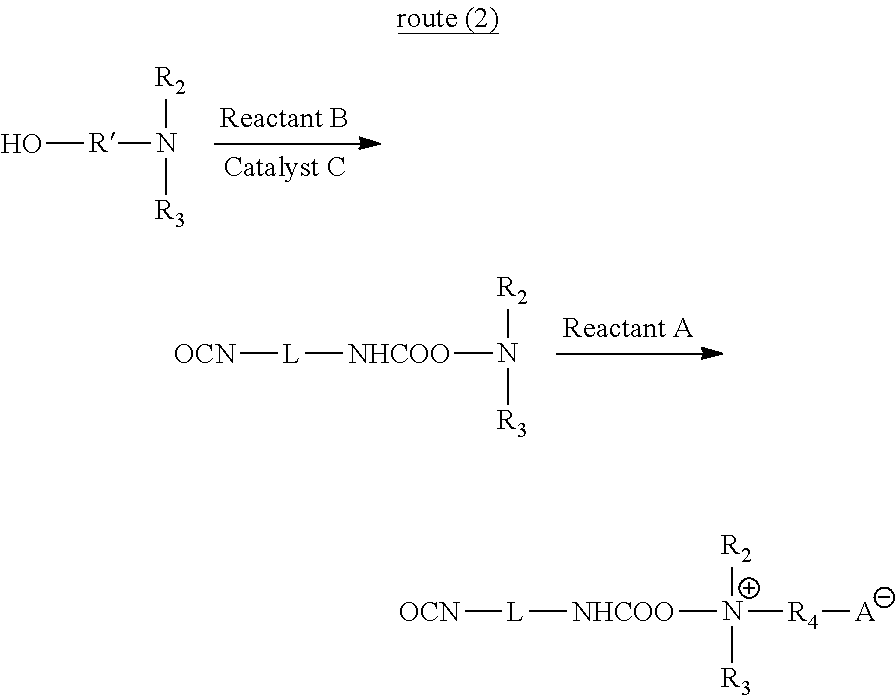Antibacterial textile and method for preparing the same
a textile and textile technology, applied in the field of antibacterial textiles and antifouling textiles, can solve the problems of poor washability of the resulting textile, long and complex production process of conventional methods for manufacturing antibacterial textiles, and high starting materials, and achieve the effects of improving antibacterial performance and washability, easy to carry out, and durable antibacterial
- Summary
- Abstract
- Description
- Claims
- Application Information
AI Technical Summary
Benefits of technology
Problems solved by technology
Method used
Image
Examples
example 1
[0074]Preparation of Lasting Antibacterial and Anti-Fouling Textile
[0075]S1: Textile was soaked in an antibacterial finishing solution containing an isocyanate-terminated betaine compound for 10 min.
[0076]S2: The textile processed in S1 was dried at 120° C. to yield an intermediate.
[0077]S3: The intermediate obtained in S2 was washed and shaped, then the intermediate was dried to yield the lasting antibacterial and anti-fouling textile.
[0078]The antibacterial finishing solution comprises: 20 wt. % of the isocyanate-terminated betaine compound, and between 80 wt. % of ethyl alcohol.
[0079]A structure of the isocyanate-terminated betaine compound is:
[0080]
[0081]A method for preparing the isocyanate-terminated betaine compound is as follows: 44.6 g of isophorone diisocyanate (IPDI) was added in a mechanically agitated round-bottom flask. 0.2 mL of catalyst dibutyltin dilaurate was added in the IPDI, and 17.8 g of dimethylethanolamine (HO CH2CH2N(CH3)2) was added dropwise in the IPDI whi...
example 2
[0083]Preparation of Lasting Antibacterial and Anti-Fouling Textile
[0084]S1: Textile was soaked in an antibacterial finishing solution containing an isocyanate-terminated betaine compound for 30 min.
[0085]S2: The textile processed in S1 was dried at 100° C. to yield an intermediate.
[0086]S3: The intermediate obtained in S2 was washed and shaped, then the intermediate was dried to yield the lasting antibacterial and anti-fouling textile.
[0087]The antibacterial finishing solution comprises: 15 wt. % of the isocyanate-terminated betaine compound, and between 85 wt. % of ethyl alcohol.
[0088]A structure of the isocyanate-terminated betaine compound is:
[0089]
[0090]A method for preparing the isocyanate-terminated betaine compound is as follows:
[0091]44.6 g of diphenylmethane diisocyanate (MDI) was added in a mechanically agitated round-bottom flask. 0.2 mL of catalyst dibutyltin dilaurate was added in the MDI, and 20.6 of diethyl ethanolamine (HO CH2CH2N(CH2CH3)2) was added dropwise in the...
example 3
[0093]Preparation of Lasting Antibacterial and Anti-Fouling Textile
[0094]S1: Textile was soaked in an antibacterial finishing solution containing an isocyanate-terminated betaine compound for 60 min.
[0095]S2: The textile processed in S1 was dried at 80° C. to yield an intermediate.
[0096]S3: The intermediate obtained in S2 was washed and shaped, then the intermediate was dried to yield the lasting antibacterial and anti-fouling textile.
[0097]The antibacterial finishing solution comprises: 10 wt. % of the isocyanate-terminated betaine compound, and between 90 wt. % of ethyl alcohol.
[0098]A structure of the isocyanate-terminated betaine compound is:
[0099]
[0100]A method for preparing the isocyanate-terminated betaine compound is as follows:
[0101]44.6 g of hexamethylene diisocyanate (HDI) was added in a mechanically agitated round-bottom flask. 0.2 mL of catalyst stannous octoate was added in the HDI, and 17.8 g of N,N-dimethylaminoethanol (HO CH2CH2N(CH3)2) was added dropwise in the HDI...
PUM
| Property | Measurement | Unit |
|---|---|---|
| temperature | aaaaa | aaaaa |
| temperature | aaaaa | aaaaa |
| temperature | aaaaa | aaaaa |
Abstract
Description
Claims
Application Information
 Login to View More
Login to View More - R&D
- Intellectual Property
- Life Sciences
- Materials
- Tech Scout
- Unparalleled Data Quality
- Higher Quality Content
- 60% Fewer Hallucinations
Browse by: Latest US Patents, China's latest patents, Technical Efficacy Thesaurus, Application Domain, Technology Topic, Popular Technical Reports.
© 2025 PatSnap. All rights reserved.Legal|Privacy policy|Modern Slavery Act Transparency Statement|Sitemap|About US| Contact US: help@patsnap.com



